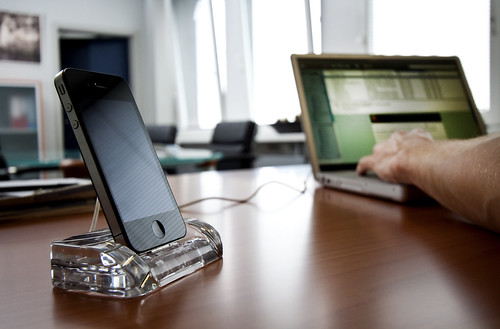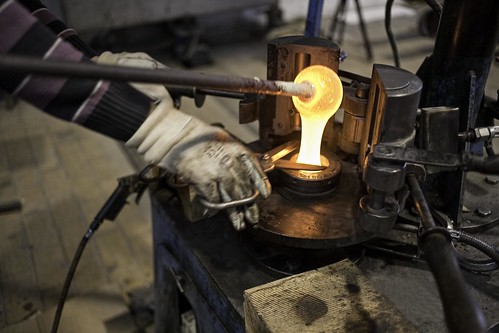Hi Chris, tell us a few words about yourself.
Chris: I am the founder and CEO of Locutio, a developer of premium branded voices for GPS. Before setting up Locutio back in 2004, I was a management consultant. Having missed the DotCom boom, I really fancied doing something a bit different. When the GPS market started to take off a few years ago, I saw a market gap for replacement celebrity voice content.
 So, you’re running a small business, but the chances are that the results of your work might get to millions of cars on the road today. What is it about exactly?
So, you’re running a small business, but the chances are that the results of your work might get to millions of cars on the road today. What is it about exactly?
Chris: It’s about giving people a choice to replace the fairly boring voice that comes with their GPS with an iconic voice they know and love. We’ve launched the original voices of Snoop Dogg, Homer Simpson, C-3PO, Yoda, and Darth Vader, as well as the Looney Tunes voices. It certainly makes the journey more fun, and it’s about to get more interesting, too, now that GPS is being pushed hard on mobile devices.
How did you come up with the idea? I’ve been using a GPS for many years now, and I never even thought there might be a business related to the GPS device itself other than mounting devices.
Chris: You know, it really was the result of a conversation in a pub, one of those “that’s a cool idea. I wonder if it’s already been done” type discussions. To my surprise, it hadn’t. That was back in 2004. It really was an uphill slog for the first five years. We had almost no money, no customers but lots of interest.
In fact, GPS and location-based services are one of the hottest sectors around right now – think about the interest Foursquare and Facebook Places are generating. We are simply trying to provide premium content that, as well as generating revenue in its own right, will also encourage people to use apps like Google Navigation and drive advertising revenues.
I think you could call voices for GPS systems a niche product. How do you evaluate if the niche is big enough to bring enough revenues?
Chris: By 2015, it is estimated that there will be around two hundred million GPS-enabled phones worldwide. By 2020, that number will grow substantially again. So for us, it is a sizeable niche we intend to exploit! Mobile carriers and manufacturers have made big investments into GPS technologies to date. So anything that gets people interested in the navigation experience is going to help sell those tariffs and encourage customers to use their data plans.
When we started, we had no idea how big the market was for these products. This was simply down to the fact that the industry was so new, and there were no data to analyze. I recall doing a crude “how many people in every 100 would be likely to buy a voice” type projection. In truth, I was just really excited about the product. My enthusiasm and interest were enough to motivate me and others to bootstrap and go through the pain of a start-up company. If you aren’t excited about it, don’t do it! I’m also a great believer in the maxim, “build it, and they will come.”
We’ve been cash positive for a while now since we changed our business model in late 2008. We’ve been making celebrity sound-a-like based products before then. Sales were slow, and we realized that unless we got a major voice out there, then we’d never get traction.
What was the first premium celebrity voice you produced for a GPS device?
Chris: It was the original voice of Homer Simpson, launched in June 2009 on TomTom.com. Homer kick-started the industry, in a sense, as he was the first premium animated character to come out on GPS.
And what are the most appreciated or make the most sales?
Chris: Well, Homer sold fantastically well – the bestselling GPS voice ever. We did a deal with Lucasfilm to bring the official voices of Star Wars to GPS, and these are selling very well too. You can get them on the TomTom iPhone app as well in Europe. We also brought the official Looney Tunes voices to TomTom in partnership with Warner Bros. this past September. There’s Bugs, Daffy, Sylvester, Yosemite Sam, and Pepe LePew. Adding the original 1940s music scores to work on the Looney Tunes voices was a challenge, but it really sounds like they’ve come straight from your favorite cartoon. Snoop’s voice still gets a lot of attention in places like Australia and Europe.
I have to say, I’ve looked at this Star Wars voice sample, called a good friend that loves Star Wars. He was heading home from the office, and when I told him about the Star Wars GPS, he told me he would buy the GPS the minute he goes home just for this. Did you expect this kind of response from the market?
Chris: When we started the company, I personally thought that the voices would drive sales of GPS. This is starting to happen now that there are some very high-quality, premium voices out there. However, the voices are part of the wider customization trend, where people expect their GPS – just like their mobile phone – to feature various useful services and fun content. After all, most of us want to personalize our consumer electronics devices in some way.
I think it even goes beyond personalization for some people, like your friend, for example. He’s obviously a fan of Star Wars and wants to trigger all those great associations when he’s driving around. If done well, the voices can really be a lot of fun!
Do you have a small business with around 4 people? How can a small business like yours make deals with big companies like TomTom and Warner Bros? What gets you to their table?
Chris: Innovation, mainly. We just stuck to it and continued to improve the product. Licensors love the idea as there are very few products that are unique and that only rely on the aural dimension. TomTom liked the idea because they are pretty advanced in executing their content and services strategy; they have a wide portfolio of cool content, of which branded GPS voices are a key element. We delivered the Star Wars voices to them in four languages, which was important for their overall content portfolio.
I also think it is about passion: the people that license The Simpsons want to work with innovative companies that do something very well with a lot of enthusiasm that will enhance their brand. It also helps that once you’ve signed a major deal with a large licensor, you have a lot of credibility in the marketplace.
What was the most important moment or development that ensured the success of the business? Is there a tipping point when you know you are successful?
Chris: Getting the Fox deal to bring The Simpsons to GPS. It took 39 months from the first meeting until Homer came out on TomTom in June 2009. Fox and Gracie loved the idea, but The Simpsons film and other things got in the way. The delays in getting the product to market were more due to timing and logistics than anything else.
Also, being able to draw a full-time salary was a big moment for me. It took 5 years from inception to the first proper paycheck. That was a good day!
By the way, what is your typical customer?
Chris: Males in their late 30s. But this is changing as the customers who have mobile GPS are getting younger and more diverse demographically.
And how exactly can people get the voices on their devices?
Chris: At the moment, The Simpsons, Star Wars, Snoop, and Looney Tunes voices are only available at www.TomTom.com. If you have TomTom on your iPhone in Europe, you go to ‘change voice,’ and the Star Wars voices will show up in your ‘change voice’ menu. If you have a PND, you know the kind of GPS you stick on your windshield, then you plug your TomTom in and follow the brief instructions. You can get the voices from our own voice portal at www.voiceskins.com, too.
Some advice for people wanting to start a small business during the crisis?
Chris: It’s funny, but our product took off in the recession as it is a low price, fun impulse-based purchase – much cheaper than buying a whole new gadget! So, in a sense, it makes sense to do something recession-friendly. But in terms of the more subtle aspects, I’d say never give up on your vision. Sometimes, it takes people time to catch up. You’ll need faith. By faith, I mean the ability to trust that somehow it will work out. Put your ego and fear to one side; I liken it to climbing a mountain – after a while, it’s as hard to go back down as it is to keep climbing up. All the technical stuff like business planning, cash flow forecasting, and the like comes with time and experience. The soft, less tangible aspects like faith, belief, trust that I found the most challenging.
What would be your words of wisdom for people not finding a business idea?
Chris: You don’t have to come up with something new. In fact, there are good reasons not to follow my path and put everything on the line for a product or market that doesn’t yet exist. Sometimes, just improving something that already exists and executing with a bit more flair and effort is all it takes.
But if you can find something that floats your boat, do it!



